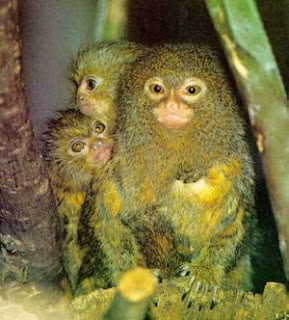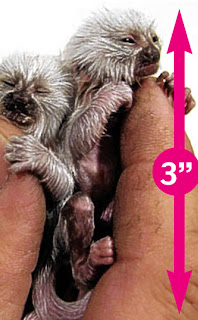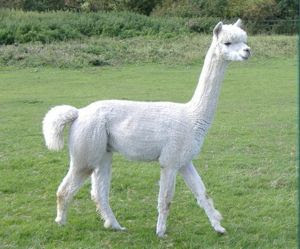skip to main |
skip to sidebar

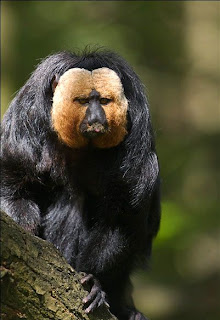
White-faced Saki Monkey
(Pithecia pithecia)
- The White-faced Saki (Pithecia pithecia), also known as the Guianan Saki and the Golden-faced Saki,
- is a species of saki monkey,
- a type of New World monkey, found in Brazil, French Guiana, Guyana, Suriname, and Venezuela.
- This monkey mostly feed on fruits, but also nuts, seeds, and insects.
Pygmy Marmoset
(Callithrix (Cebuella)
- The Pygmy Marmoset (Callithrix (Cebuella) pygmaea) is a monkey native to the rainforest canopies of western Brazil , southeastern Colombia , eastern Ecuador , and eastern Peru .
- It is one of the smallest primates, with its body length ranging from 14-16 cm (excluding the 15-20 cm tail) and the smallest monkey. Males weigh around 140 g (5 ounces), and females only 120 g ( 4.2 ounces).
- Despite its name, the Pygmy Marmoset is somewhat different from the typical marmosets classified in genus Callithrix. As such, it is accorded its own subgenus, which was formerly recognized as its own genus, Cebuella.
- The Pygmy Marmoset has a tawny coat, and a ringed tail that can be as long as its body.
- Their claws are specially adapted for climbing trees, a trait unique to the species.
- They are omnivorous, feeding on fruit, leaves, insects, and sometimes even small reptiles.
- Much of their diet, however, comes from tapping trees for sap.
- Up to two-thirds of their time is spent gouging tree bark to reach the gummy sap.
- The Pygmy Marmoset has specialized incisors for gouging holes in bark. Unfortunately, because of its small size, and its swift movements, it is very hard to observe in the wild.
- In captivity, the Pygmy Marmoset can live up to 11 years.
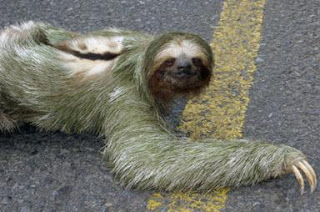
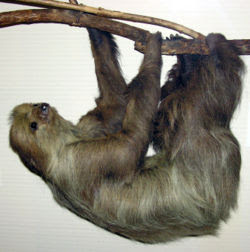
Sloth
- Sloths are medium-sized mammals that live in Central and South America belonging to the families Megalonychidae and Bradypodidae, part of the order Pilosa.
- Most scientists call these two families the Folivora suborder, while some call it Phyllophaga.
- Sloths are omnivores. They may eat insects, small lizards and carrion, but their diet consists mostly of buds, tender shoots, and leaves.
- Sloths have made extraordinary adaptations to an arboreal browsing lifestyle.
- Leaves, their main food source, provide very little energy or nutrition and do not digest easily: sloths have very large, specialized, slow-acting stomachs with multiple compartments in which symbiotic bacteria break down the tough leaves.
- As much as two-thirds of a well-fed sloth's body-weight consists of the contents of its stomach, and the digestive process can take as long as a month or more to complete.
- Even so, leaves provide little energy, and sloths deal with this by a range of economy measures: they have very low metabolic rates (less than half of that expected for a creature of their size), and maintain low body temperatures when active (30 to 34 degrees Celsius or 86 to 93 degrees Fahrenheit), and still lower temperatures when resting.
- Sloths mainly live in Cecropia trees.


Emperor Tamarin
(Saguinus imperator)
- The Emperor Tamarin (Saguinus imperator) is a tamarin allegedly named for its similarity with the German emperor Wilhelm II. The name was first intended as a joke, but has become the official scientific name.
- This tamarin lives in the southwest Amazon Basin , in east Peru , north Bolivia and in the west Brazilian states of Acre and Amazonas.
- The fur of the Emperor Tamarin is predominantly grey colored, with yellowish speckles on its chest.
- The hands and feet are black and the tail is brown.
- Outstanding is its long, white mustache, which extends to both sides beyond the shoulders. The animal reaches a length of 24 to 26 cm, plus a 35 cm long tail. It weighs approximately 300 to 400 g.
- This primate inhabits tropical rain forests, living deep in the forest and also in open tree-covered areas. It is a diurnal animal, spending the majority of its days in the trees with quick, safe movements and broad jumps among the limbs.
Proboscis Monkey
- Nasalis larvatus also known as Long-nosed Monkey is a reddish-brown arboreal Old World monkey. It is the only species in monotypic genus Nasalis.
- The most distinctive trait of this monkey is the male's large protruding nose. The purpose of the large nose is unclear, but it has been suggested that it is a result of sexual selection. The female Proboscis Monkey prefers big-nosed male s , thus propagating the trait.
- Males are much larger than females, reaching 72 cm (28 inches) in length, with an up to 75 cm tail, and weighing up to 24 kg (53 pounds). Females are up to 60 cm long, weighing up to 12 kg (26 lb).
- The Proboscis Monkey also has a large belly, as a result of its diet. Its digestive system is divided into several parts, with distinctive gut flora, which help in digesting leaves. This digestive process releases a lot of gas, resulting in the monkey's 'bloated' bellies. A side-effect of this unique digestive system is that it is unable to digest ripe fruit, unlike most other simians. The diet consists mainly of fruits, seeds and leaves.
*Images & Information taken from WIKIPEDIA, the free encyclopedia that anyone can edit ..
The Alpaca
(Vicugna pacos)
- domesticated species of South American camelid developed from the wild alpacas.
- resembles a sheep in appearance, but is larger and has a long erect neck as well as coming in many colors, whereas sheep are generally bred to be white and black.
- kept in herds that graze on the level heights of the Andes of Ecuador, southern Peru , northern Bolivia , and northern Chile at an altitude of 3500 to 5000 meters above sea-level, throughout the year.
- considerably smaller than llamas, and unlike them are not used as beasts of burden but are valued only for their fiber.
- Alpacas only have fleece fibers, not woolen fibers, used for making knitted and woven items much as sheeps wool is.
- These items include blankets, sweaters, hats, gloves, scarves, a wide variety of textiles and ponchos in South America , and sweaters, socks and coats in other parts of the world.
- The fiber comes in more than 52 natural colors as classified in Peru , 12 as classified in Australia and 22 as classified in America .
- The Angora rabbit is a variety of domestic rabbit bred for its long, soft hair.
- The Angora is one of the oldest types of domestic rabbit, originating in Ankara , Turkey , along with the Angora cat and Angora goat.
- The rabbits were popular pets with French royalty in the mid 1700s, and spread to other parts of Europe by the end of the century.
- They first appeared in the United States in the early 1900s.
- They are bred largely for their long wool, which may be removed by shearing or plucking (gently pulling loose wool).
- There are many individual breeds of Angora rabbits, four of which are ARBA recognized. Such breeds include, French, German, Giant, English, Satin, Chinese, Swiss, Finnish, to name a few.
Komondor Dog
- Females are 27 inches (69cm) at the withers.
- Male Komondorok are a minimum of 28 inches at the withers, but many are over 30 inches tall, making this one of the larger common breeds of dog.
- The body is not overly coarse or heavy, however, and people unfamiliar with the breed are often surprised by how quick and agile the dogs are.
- Its long, thick, strikingly corded white coat (the heaviest amount of fur in the canine world) resembles dreadlocks or a mop.
- The Komondor is born with only a white coat, unlike the similar-looking Puli, which is usually white, black or sometimes grayish.


Red Panda
(Ailurus fulgens)
- The Red Panda, Ailurus fulgens ('shining cat,' from a Latinized form of the Greek, ailouros, 'cat,' and the participial form of the Latin fulgere, 'to shine') is a mostly herbivorous mammal, slightly larger than a domestic cat (55 cm long).
- The Red Panda has semi-retractile claws and, like the Giant Panda, has a 'false thumb' which is really an extension of the wrist bone.
- Thick fur on the soles of the feet offers protection from cold and hides scent glands.
- The Red Panda is native to the Himalayas in Nepal and southern China .
- The word panda is derived from Nepalese word 'ponya' which means bamboo and plants eating animals in Nepal .


Shoebill
(Balaeniceps rex)
- The Shoebill, Balaeniceps rex also known as Whalehead is a very large bird related to the storks.
- It derives its name from its massive shoe-shaped bill.
- The Shoebill is a very large bird, averaging 1.2 m (4 ft) tall, 5.6 kg (12.3 lbs) and 2.33 m (7.7 ft) across the wings.
- The adult is mainly grey, the juveniles are browner.
- It lives in tropical east Africa, in large swamps from Sudan to Zambia .
- The Shoebill was added rather recently to the ornithological lists; the species was only discovered in the 19th century when some skins were brought to Europe .
- It was not until years later that live specimens reached the scientific community.
- The bird was known to both ancient Egyptians and Arabs however.
- There exist Egyptian images depicting the Shoebill while the Arabs referred to the bird as abu markub, which means one with a shoe. Clearly, this refers to the striking bill.

 The Sun Bear
The Sun Bear
(Helarctos malayanus)
- Sun Bear (Helarctos malayanus) is a bear found primarily in the tropical rainforests of Southeast Asia .
- The Sun Bear stands approximately 4 ft (1.2 m) in length, making it the smallest member in the bear family.
- It is often called the dog bear because of its small stature. It has a 2 in (5 cm) tail and on average weighs less than 145 lb (65 kg). Males tend to be slightly larger than females.
- Unlike other bears, the Sun Bear's fur is short and sleek.
- This adaptation is probably due to the lowland climates it inhabits.
- Dark black or brown-black fur covers its body, except on the chest where there is a pale orange-yellow marking in the shape of a horseshoe.
- Similar colored fur can be found around the muzzle and the eyes. This distinct marking gives the sun bear its name.




